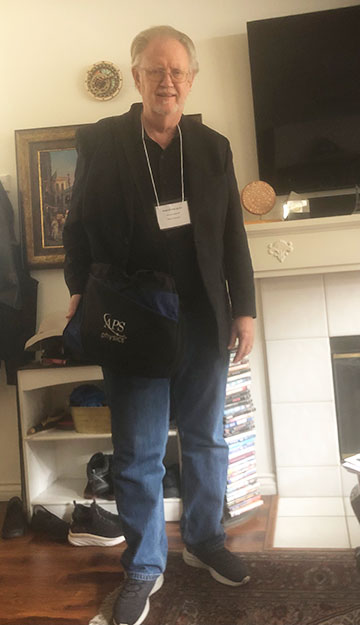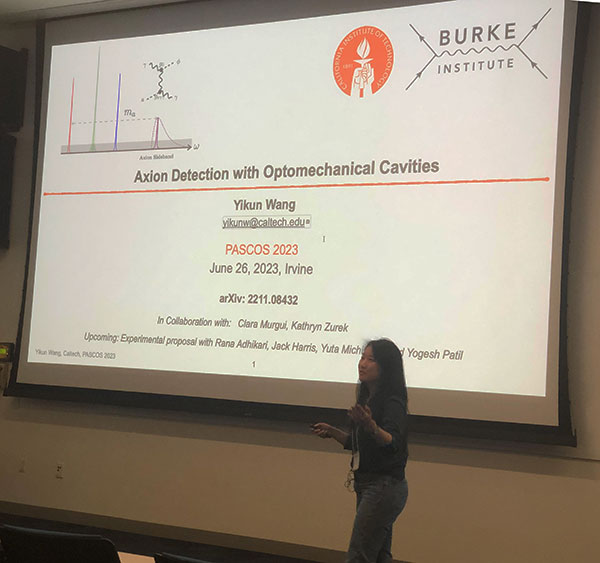Greetings from Palmia Observatory
Well it is finally time for PASCOS 2023, June 26-30, held at UC Irvine this year. PASCOS has international speakers in three main areas of study: Particle Physics, String Theory and Cosmology.
It has been at least 2 years of COVID shutdown since the UCI campus has opened up and has begun the movement away from Zoom and back to in room meetings. I had to learn all over again the intricacies of buying a campus parking pass from the little machines in the parking lots. Here the Resident Astronomer gets ready to attend the conference for the 2nd day. The first day was very technical and I was not prepared to understand many of the topics.
 |
| Resident Astronomer ready to go to PASCOS 2023 (Source: Palmia Observatory) |
The PASCOS conference is held in the Interdisciplinary Science and Engineering Building (ISEM) which was just constructed in 2021. The conference auditorium was pretty much full with all of the attendees.
 |
| PASCOS 2023 attendees ready to go in ISEB 1010 (Source: Palmia Observatory) |
Many of the plenary sessions were quite technical and seemed a little higher level of technicality that what I would normally expect in a plenary session. Here Professor Lindner, MPIK, explains that notwithstanding the overwhelming success of the standard model of particle physics, there are still other problems, such as the nature of dark matter and dark energy, and the standard model has no good explanation. He lists some of the other issues in this introductory slide.
 |
| Some reasons for searching beyond the standard model (Source: M. Lindner, MPIK, PASCOS 2023) |
One of ongoing searches for particles and physics beyond the standard model is looking for the hypothetical axion. Here, Yikun Wang, Caltech, previews one of the ongoing search methods. It still seems strange that physicists can identify theoretical particles and predict that if they have the assumed properties then they should be detectable by the various ongoing methods. What we see with approach is the available parameter space in which the particle hide just keeps getting smaller and smaller. How far do you keep searching until you just decide to give up and realize that the hypothetical particle just doesn't exist? Mabe when the money runs out?
 |
| Axion Detection Methods with Optomechanical Cavities (Source: Yikun Wang at PASCOS 2023) |
Whenever the speaker introduced some physics terminology or concept that I didn't quite understand or remember the details, I decided to use ChatGPT as my "study buddy" and see if I could get a simpler explanation. One bullet point in one of the slides was "The implications of BSM (Beyond Standard Model) Phenomenology." What does that mean? Well, here is the first part of a longer explanation that ChatGPT offered:
 |
| Using ChatGPT to explain "Implications of BSM Phenomenology" (Source: Palmia Observatory) |
That seems to be a pretty cogent explanation and description. So far so good! Another aspect of particle physics that kept showing up in several presentations was the idea of particles being a "singlet" or "triplet" configuration. Again, I had some idea about what this meant, but elected to ask ChatGPT again.
 |
| Using ChatGPT to explain unknown physics term: "gauge singlet" (Source: Palmia Observatory) |
Ok, so that helps, but now I need to go back and review other concepts from gauge theory such as gauge forces and more. I am starting to appreciate how ChatGPT can be a study buddy, who just like our real study friends can be right sometimes and wrong sometimes.
More about that later, but we finally have a coffee break and time for a restroom break too. Hmm, you know you are on a college campus when you see evidence of consideration of the latest in social issues. I had never seen this sign on a restroom door before. I kind of understood that I was qualified to use the facilities but elected to use the less risky one just marked "Men."
 |
| Inclusive restroom in ISEB with updated signage (Source: Palmia Observatory) |
So far we have seen a lot of presentations on particle physics and I kept waiting for some presentations on cosmology. This presentation by Deliliah Gates, Princeton, sort of went a little bit into cosmology but only to discuss how there might be some exciting new physics to be discovered right near the event horizon of black holes, especially spinning black holes. Well, I couldn't make out about the particle physics there and will have to review her presentation later in more detail. One slide that I sort of understood was a concise presentation of the Kerr metric for spinning black holes.
 |
| Kerr Metric for spinning black holes (Source: Delilah Gates, Princeton, PASCOS 2023) |
One of my favorite presentations was done by Stuart Raby, Ohio State, who gave a great historical perspective on particle physics. We have come a long way from the first theories of Maxwell and others when electricity and magnetism were unified.
 |
| Stuart Raby explores perspectives in particle physics and his new book (Source: Palmia Observatory) |
After the presentation, I looked up Raby's book and was so impressed I just bought the book on Amazon and downloaded it then and there. This might be the textbook that finally fits my level of trying to understand the physics of the Standard Model. Here is the first page of the contents of the book and you can see the introductory topics, all of which are necessary to gain an understanding and the number of pages assigned to each topic. The contents show other sections that go into the details and explanation of the need to go beyond the current standard model of particle physics.
 |
| First page of content shows easy beginnings for students (Source: Raby, "Introduction to the Standard Model and Beyond") |
Maybe when I get back to the observatory I can get a good start in reviewing the standard model physics as outlined in the book.
Finally, we should mention this presentation by Graciela Gelmini, UCLA on Catastrogenesis. What really kept my attention in this presentation was how the observation of gravitational waves could lead to new physics. Who new that theories describing collapsing strings or theories of inflation indicate that the gravitational waves of those events could theoretically be observable.
Remember how Brian Keating described in his book, "Losing the Nobel Prize" the sad story how early excitement of supposed observation of the gravitational wave effects on inflation were thought to have been observed, but instead the observations were contaminated by galactic dust.
So Graciela laid out some of the effects that might be observed in the future. This is the first time that I had heard of collapsing strings and how that might have affected the early universe and left some imprint behind that might be seen today. Will these effects be observed? Maybe they already have been observed. Recall that some of us are waiting for the upcoming announcement by the NanoGrav Collaboration, who has scheduled a news conference for a "big" announcement, this Thursday, June 29. We will have to wait and see.
 |
| Catastrogenesis and how gravity waves might indicate new physics (Source: Graciela Gelmini, UCLA, PASCOS 2023) |
Well, I have to tell you that I am completely worn out at spending some days at PASCOS. I was too tired to open up Raby's book. So here, with the help of a martini, I can rest up, get ready for more lectures tomorrow and hopefully not spill the martini!
 |
| Resident Astronomer wiped out with martini after PASCOS day 1 (Source: Palmia Observatory) |
Until next time,

No comments:
Post a Comment